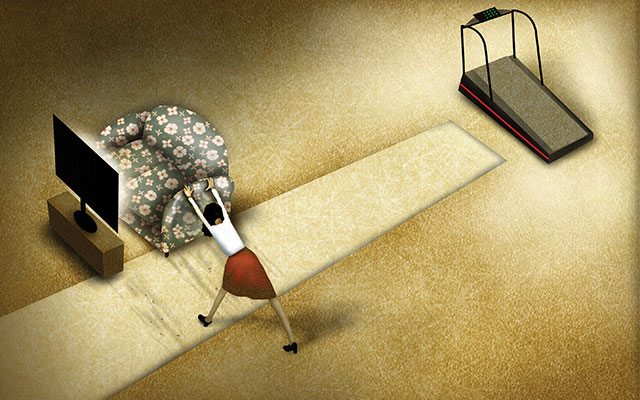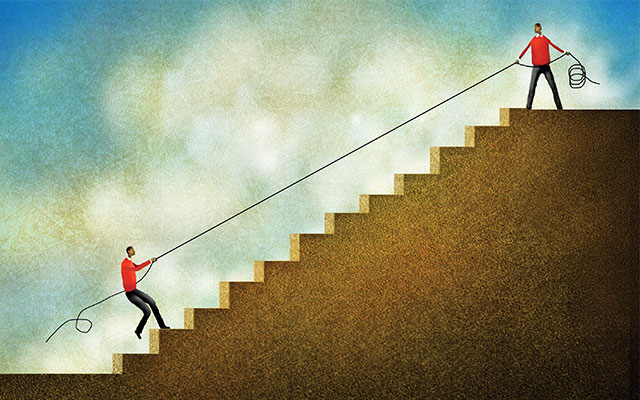Have you ever felt like you were in a rut? Of course you have! We all have.
Feeling stuck in your day-to-day routine is a universal experience. It’s also a byproduct of your highly efficient brain. After all, with an estimated 11 million sensory inputs to process each second, your brain would be unnecessarily taxed if it had to relearn how to shower and tie your shoes each day. Instead, its myelinated neural networks allow routine behaviors to become default behaviors. (For more on this, see the second article in this series at “Relapse Recovery“.)
So if what you’re doing is working for you — even remotely — you tend to stick with it. Default behavior can be constructive (brushing and flossing daily) or unconstructive (downing a few cocktails nightly). Ruts may manifest as lack of action, as well: Maybe you keep your head down at work, never taking on projects outside your comfort zone. Or you stay in an unhealthy relationship for years, avoiding conflict and change.
Biologists have observed that animals in nature will take the same paths and escape routes through their territories over and over — often falling victim to predators who exploit this predictability. What if some of your ruts are ill-conceived escape routes — patterns of action or thought that keep you from dealing with problems, rising to challenges, or tending to relationships?
And what if these ruts have negative consequences? Wolves may not eat you, but your partner, boss, or friends may let you know that your default behavior is causing problems.
An Antidote to Ruts
In his research with animals, Jaak Panksepp, PhD, professor of integrative physiology and neuroscience at Washington State University, identified seven core neural networks of emotion, the strongest of which he defined as “seeking,” or the desire to discover. This emotion compels an animal to find a mate, forage for food, and learn new parts of its habitat, all of which are essential for survival.
Just like any other animal, humans are drawn to discover. Using fMRI (functional magnetic resonance imaging), researchers have found that a region in the midbrain called the substantia nigra/ventral tegmental area, or SN/VTA, is activated when a person is exposed to novel stimuli. We are hardwired to notice and gravitate toward the new — new people, new house, new job, new vacation destination.
When we combine a neurological tendency to automate routine behavior with a biological drive to seek, it makes sense that we check our phones some 85 times per day. In fact, the act of seeking — more than actually discovering — really lights up our brains. Dopamine, a neurotransmitter associated with motivation and reward, spikes in anticipation of discovery.
That seeking behavior manifests in many ways — some beneficial, some benign, some problematic. If you’ve ever spent too much money shopping for things you didn’t really need, you know that seeking is often more satisfying than what you ultimately find, learn, or buy. You can even get addicted to seeking, which may be distracting but does nothing to release you from (or provide insight into) your ruts.
Instead, why not use the principles of design thinking to break out of your ruts? Why not design a beneficial seeking behavior — a quest — that allows you to seek in deeper and more meaningful ways?
Design Your Quest
For the past 20 years, I have embarked on an annual solo quest to help myself climb out of my ruts. For five days, I camp in a remote wilderness area where I fast and meditate in order to wake up my mind. Isolation removes the distractions of conversation and social obligation. Fasting eliminates the distractions of planning, cooking, and eating food. (Thinking about food, however, is another story!)
These days of focused meditation allow my mind to quiet itself from the emailing, texting, and rumination it’s usually engaged in. Eventually I drop into a deep silence where I can gain insights into the nature of my ruts — and the changes I need to make to get out of them. During one quest I came to understand that it was time to move on from a job I loved. While I felt passionate about the work, I had become complacent in many ways and had developed some bad habits.
Solitude and time in nature helped me see that, if I wanted to grow, I needed to release that job — a realization I may not otherwise have had until years later.
I believe there is a quest for everyone. You don’t have to venture into the wilderness to gain insight into your ruts and the changes you may need to make.
Remember, you are the designer of your life — so think like a designer! What types of experiences will really get your attention and break you out of your daily routine? How will you eliminate distractions so you can gain insight into your habits of thought and behavior?
The real adventure lies within you. Do you dare seek it?
This article originally appeared as “Breaking Free”. A version of this article first appeared in the June 2016 issue of Experience Life magazine. Click here to subscribe.




This Post Has 0 Comments